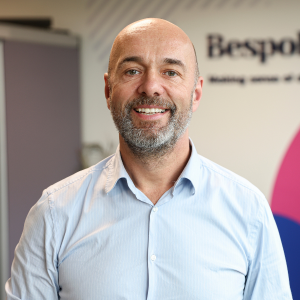
6 minutes
When starting a new marketing retainer, you should know what the commercial return on investment could be.
In this video, Steve and Phil explain how to set the right targets, the need for alignment between the client and agency, and the important metrics.
Bespoke has been delivering successful digital marketing retainers for 20+ years. Our videos are built on this knowledge.
Steve: So we've both been busy with, well one of the things we’re busy with is retainers, isn't it? Marketing agency retainers. Myself, I've seen the evolution of Bespoke and how we've managed these and for yourself, you've seen that in recent years here, but you've been client side as well.
Phil: Yeah it's interesting from being on the client side of things for many years, you know, and having targets for lead generation or sales and building those digital teams, I always had the same challenge of goal setting to get a return on investment for whatever activities we were doing with our chosen agency partner. It was exactly the same issue, but it all boils down to ROI, whether you're in-house or whether, you know, you’re sat on our side of the fence.
Steve: I think we see or hear of some retainers that either they don't have a goal to speak of, or the agency has is different for what the client has. Maybe the agency is measuring traffic or search terms, but the client wants, you know, revenue or leads or something.
Phil: Yeah and I think that's true and if they're not matched, you're not setting yourself up for success. But I think those ROI commercial conversations start generally in the workshop. Because if you can become aligned on the goals at that stage and both of you are clear on what you're setting out to achieve, then it's simple to report it. Everyone can get after the same objective and ultimately, you know, you need a return. A return on investment for that client's investment with us.
Steve: So let's say, I'm going to try and picture this. I'm in the workshop, you're running the workshop, I'm the client that's considering a retainer, I'm thinking about the marketing activity for next year, 2 years, 3 years. How would I know with the targets that was set in that workshop that I'm actually going to get a return on the retainer? There must be some way I can.
Phil: I think the first thing is to make sure we're using the same terms and metrics, you know, perhaps if the client comes in looking at social media engagement, or talking keywords, or even just talking individual marketing channels, that's probably not going to get us the result we want. We need to be talking about the investment they're prepared to make and are we going to get a minimum 5 to 1 return on that, but realistically something more like 10 to 1. And that's only going to come with identifying the value of a lead and ultimately a volume of leads and that then rolls up into a decent return on investment for the client, which then can also be scaled or turned up, you know, once those results flow.
Steve: If I dig deeper on your, like you've got oversight of all the retainers here, do you see, is there a goal on every account? And is the client sort of, you know, is there an alignment between what we regard as a goal and what they regard as a goal and result and so on?
Phil: That overarching sort of commonality? Because obviously, they've all got separate goals, clearly. But the common theme between them all is that there's an agreement between us and them as to what that goal is. But there's also a commercial return for that goal. It's not a vague metric like SEO growth or traffic, it's something defined and financial.
Steve: Right and without giving any names away, could you, is there a couple of examples of goals that you could just illustrate what a goal might be on a typical retainer or example?
Phil: Yeah, I mean, if we can, so this is where in the workshop or a different type of environment, we'd work with the client to understand what the value of, let's say, a sale is, you know, for a conversion to whatever metric we're trying to achieve. So if we know the value of, let's call it a sale, we know how many leads we can bring in suddenly, that builds a model of what that return on investment can be. It doesn't have to be lots of metrics, it can be three or four metrics that can suddenly give us a clear idea of what that return and investment could be. So for example, if we think of, perhaps an example would be a trade bathroom supplier. You know, we know the value of a lead that we bring in for them could be two or three sales. There could be a lifetime value over a given period of £2,000 - £3,000, let’s say £2,500, and that's measurable, we know that, that's a figure that's agreed and understood between us and the client. So if you take that figure and a conversion rate for sales, and a volume of leads, you've very quickly got, that rolls up into a commercial value that we can bring to the business over a given year or 12 or 18 months.
Steve: And they can look at it and they can think ‘well we've got this spend, but we've also got this outcome’, and whatever that ratio is, you say the target is 5 to 1 at least. But they can look at that as well, both parties can agree this is working or it's not working and something needs to change.
Phil: It doesn't have to be complicated, yeah, it can literally be a handful of metrics on one piece of paper, or a digital screen, that you can very quickly see the return you're getting on the investment with us. But it also, I think once you've got that baseline of understanding, from there you can, you have more confidence to then turn it up. If you feel that you've got real control over that marketing investment, you're then in a position where you can say well if you invest another £1000, we know we're going to get a 5 or 10 to 1 return on it. So there's confidence to invest more. But also, you know, the clients that we're dealing with, if they have stakeholders to manage within their business, the board directors or the owner, it's very easy to take a simple and clear defined set of metrics to prove the worth of that investment with us.
Steve: I see, great. So either way, you're obviously better off with a clear, agreed, measurable goals than without one.
Phil: Simple is better so long as it's agreed from the outset. Probably at the workshop stage or your initial conversations.
Steve: Yeah, great, lovely, thank you Phil.

